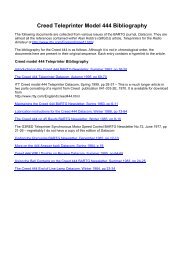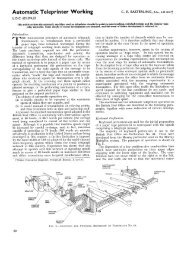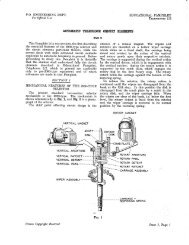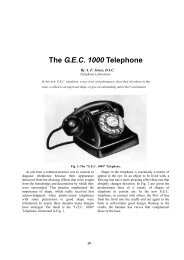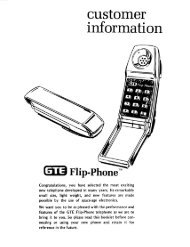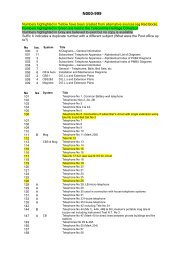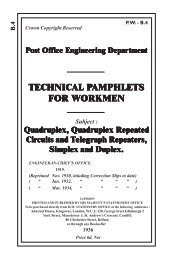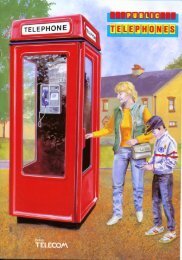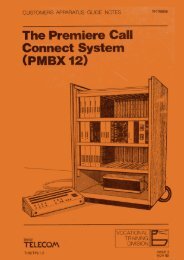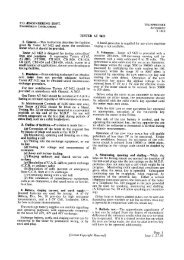TRAFFIC CONTROL TELEPHONE SYSTEMS Circuit - Sam Hallas
TRAFFIC CONTROL TELEPHONE SYSTEMS Circuit - Sam Hallas
TRAFFIC CONTROL TELEPHONE SYSTEMS Circuit - Sam Hallas
Create successful ePaper yourself
Turn your PDF publications into a flip-book with our unique Google optimized e-Paper software.
Page 4<br />
PART 1<br />
KEY SENDING SYSTEM DESCRIPTION<br />
GENERAL<br />
Selection of the required way station is obtained by a coded train of impulses,<br />
normally comprising three groups. The sum of the impulses in the three groups is the<br />
same for all codes, and the receiving apparatus is designed to respond only to the<br />
correct total, so that lost or additional impulses (due to external interference) cannot<br />
cause wrong calls. The constant total feature ensures that line interference cannot<br />
establish a wrong call but would make that call ineffective.<br />
The presence or absence in the Controller's receiver of "ring back" tone, generated<br />
by the way station bell, immediately advises him of either the completion or<br />
failure of the call.<br />
Selector Key No. 4001-A<br />
The function of the selector key is to control the operation of the battery and<br />
battery reversing relays which switch the line battery and transmit the appropriate<br />
sequence of current impulses to the line. The 4001-A Selector Key is fully described<br />
in Part 2, and this should be read in conjunction with the circuit description on page<br />
8.<br />
Battery Relay 4664-DA<br />
This relay designated BR, applies the line battery to the line before impulsing<br />
commences and switches off after the end of the ringing period. The operation of BR<br />
is controlled by the selector key.<br />
Battery Reversing Relay 4664-MX<br />
This relay, designated SR, reproduces the impulses originated by the selector<br />
key, reversing the polarity of the line with each impulse. A train of impulses therefore<br />
consists of a succession of pulses of alternating polarity.<br />
The adjustment figures for the 4664-MX Relay are given at the end of Part 8,<br />
and attention is drawn to the two notes relating to any adjustments made to this relay.<br />
It is important that the impulses due to line battery reversals sent out by SR to<br />
line should be of equal duration. The impulse ratio can be determined quite closely by<br />
observation, but more accurately by use of a centre zero voltmeter or a centre zero<br />
milliammeter with a resistance in series to limit the current. The meter should be<br />
connected directly across the line terminals and an uninterrupted train of impulses,<br />
such as the General Call code should be transmitted. If the impulse ratio is correct the



